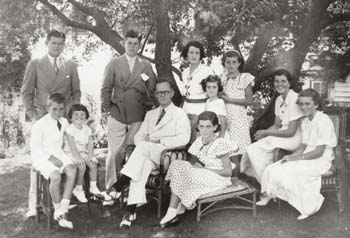 |
 |
| current issue |  |
past issues |  |
send a letter/news |  |
address update |  |
advertise |  |
about us |  |
alumni home |
Features
The Real New EnglandPage 2 of 3
 Joseph P. Kennedy and family
Joseph P. Kennedy and family
|
Even casual readers flipping through a few of the encyclopedia's 1,600 pages will inevitably stumble on some of the surprising facts and intriguing tidbits that season this text—and prove that New England can't be stereotyped. The history of PEZ candy. A vacation spot known as "Sneezer's Paradise." A Turkish cymbal-making company. The great cookie controversy. The state that declared war on Nazi Germany in 1941, before Pearl Harbor. The divination properties of the apple. The sports invented in New England. The percentage of New Englanders who can claim English ancestry. The one state with a majority Catholic population. The dubious connection between tuberculosis and vampires. The folktale of the jumping doughnuts.
Readers also encounter numerous entries detailing New England's conflicts and complexities. In 1927, for example, during the nationwide anticommunist and anti-immigrant frenzy known as the Red Scare, two Italian immigrants, Bartolomeo Vanzetti and Nicola Sacco, were accused and convicted of murder—and ultimately executed for their alleged crime. Scholars today still debate whether the two were guilty. The encyclopedia's account of the trial includes Vanzetti's moving words: "Never in our full life, could we hope to do such work for tolerance, for justice, for man's understanding of man as now we do by an accident...The taking of our lives—lives of a good shoemaker and a poor fish peddler... That last moment belongs to us—that agony is our triumph." The trial, concludes the entry, "continues to remind Americans how fragile constitutional rights can be in times of extreme national hysteria."
Accounts like these offer poignant examples of the need to retell the stories of our past—even those that are painful. "Culture is not always pretty," says Watters, who directs UNH's Center for New England Culture. But a reexamination of the past, including its intolerances and tensions, has something to teach us about today. It helps us to remember. And the importance of memory, says Watters is "a defining characteristic of New England. Without memory, the sense of communal purpose can easily be lost, and with it, community, spiritual growth, prosperity and history itself." The encyclopedia is one weapon in the arsenal of fighting forgetfulness.

|

|

|
Feintuch, who came to UNH in 1988 from Western Kentucky University, had contributed to the award-winning Encyclopedia of Southern Culture. "I thought it would be great to sponsor something like that here," he says. So he and Watters began looking for publishers. "Everyone told us to get the money together first," says Feintuch. "They suggested about a million dollars." The two forged ahead anyway. Along with support from UNH, the encyclopedia eventually received substantial funding from the National Endowment for the Humanities. "I am especially pleased that your encyclopedia will carefully explore both the older Yankee culture and the more recent ethnic and black traditions that have shaped New England life," wrote William Ferris, then-director of the NEH. "These diverse, complex worlds will offer an important new understanding of New England."
Feintuch and Watters are especially proud of the encyclopedia's emphasis on the richness of New England's ethnic traditions. There are photos of Latin American children in traditional Sunday dress, Vietnamese children at a New Year's celebration, African American children staging the Black Nativity. There are photos of a Micmac craftsman, a mural in Chinatown and an Armenian family in traditional dress. Every immigrant group is represented and the role they played in the region's development is acknowledged. "We were very self-conscious about the fact that the image of New England had always been a white image," says Watters. "We wanted everybody to find themselves in this book—in stories of their communities and their cultures and in the pictures themselves."
This inclusive approach characterizes every section of the encyclopedia, which takes very seriously its role in helping to preserve the culture it defines. "There is a crying need to document New England's everyday life and its folklife," writes Watters, "to preserve the cultural record and history, as well as the region's contemporary culture." Not an easy task, certainly, but just the thing for UNH, according to Feintuch and Watters. "It's the type of thing you find at a land grant institution that cares about the world," says Feintuch, "and it's very much in keeping with our mission."
Page: < Prev 1 2 3 Next >Easy to print version

